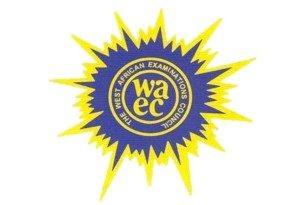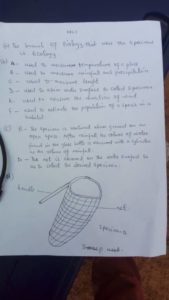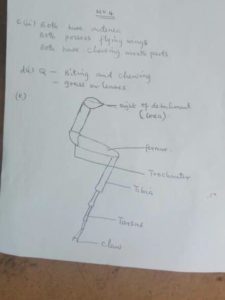WAEC 2019 BIOLOGY PRACTICAL VERIFIED ANSWER

(Biology Practical Answer)
(1a)
The branch of biology that involves the use of specimen A, B,C,D,E and F is ecology
(1b)
A – use for measuring temperature or determine the degree of hottest or coldness of the an object/organ/organism
B- for measuring the amount and volume of rainfall in an ecosystem
C – (i) to measure the length, height and width of an object /length
(ii)to measure the growth rate of ab organism
D- for collecting insect/creeping and crawling animal
E – for finding wind direction
F – To establish population of plants in an ecosystem
(1c)
B – The specimen is stationed above ground on an open space. After rainfall, the volume of water found in the glass bottle is measured with a cylinder as the volume of rainfall
D – The net is skimmed on the water surface so as to collect the desired specimen
(1d)
Loading
(1e)
Specimen D
(i)housefly
(ii) grasshopper
Specimen F
(i)housefly
(ii)mosquito

=====================
(2ai)
Kingdom – Animalia
Class – Aves
(2aii)
The specific location is the wings.
(2aiii)
Fowl
(2b)
In a tabular form
Under Specimen H
-Light brownish in colour
-Obtained from animal.
-The barbs are joined.
-The shaft is made of cuticle.
-It acts as an organ of insertion.
-specimen is soft and fluffy.
Specimen J
-Green in colour.
-Obtained from a plant.
-Each leaf is separate from one another.
-The shaft is made of wood.
-Acts as an organ of photosynthesis.
-Specimen is hard.
(2c)
H – It is used for flying.
J – it is used for photosynthesis.
(2dii)
Presence of green colouring material(chlorophyll).
Its position on the body of the plant.
=====================
(4ai)
Sex of specimen P is Male
(4aii)
The wings of male cockroach are larger than that of the females and extend beyond the abdomen.
(4bi)
Habitats
P – It can be found in dark place.
Q – It can be found in farm lands.
(4bii)
Adaptation of P
(i) Possession of antenna for detecting food.
(ii) Compound eye for wider view.
(iii) Possession of jointed pair of legs.
Adaptation of Q
(i) Possession of chitinous body cover for protection.
(ii) Presence of wings for flight.
(iii) Mandibular mouth part for chewing.
(4c)
In a tabular form:
Specimen P
Dorso-ventrally flattened to allow passage through cracks.
Specimen Q
Possession of chitinous body cover for protection.

Categories: WAEC


